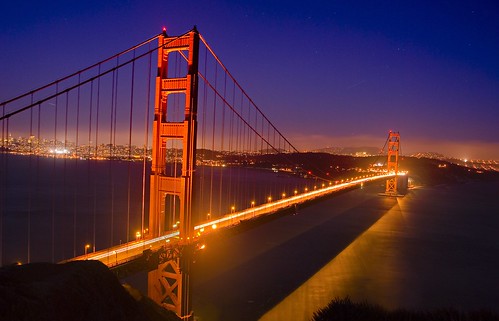I went over to the Marin Headlands to photograph the Golden Gate Bridge at sunset. At first, with the D200 on my tripod, I used a polarizer and stopped the camera down as far as possible to get the car headlights to solidify.
As the lights of San Francisco, the Golden Gate Bridge, and the stars came out, my exposures grew longer and longer. From what I could tell on the LCD viewer, my images were starting to look a little murky and pixelated (I almost wrote “grainy,” but I realized in time we don’t have grain any more!).
So I reversed course, and opened the lens up wide. After all, with a fifteen second exposure, headlights will look like a solid line without making the exposure any longer. I also used the Nikon D200 menu to turn on the long exposure option. This reduces random pixelation within an image exposed for more than eight seconds at the expense of taking longer to save the image (for a while I wondered why the camera was flashing “JOB” at me) and of making the image file size larger.
Back home, on my computer, I realized that the bridge, its shadow, and the light it projected all approached convergence. As did the image I saw in my mind’s eye when taking the picture and the digital photo I was viewing on the computer!

Pingback: Photoblog 2.0: » Photoblog 2.0 Archive: » Moonlight and the Golden Gate
Pingback: Photoblog 2.0: » Photoblog 2.0 Archive: » Golden Golden Gate Bridge
Pingback: Photoblog 2.0: » Photoblog 2.0 Archive: » Beyond the Cliff
Pingback: Photoblog 2.0: » Photoblog 2.0 Archive: » Starry Night